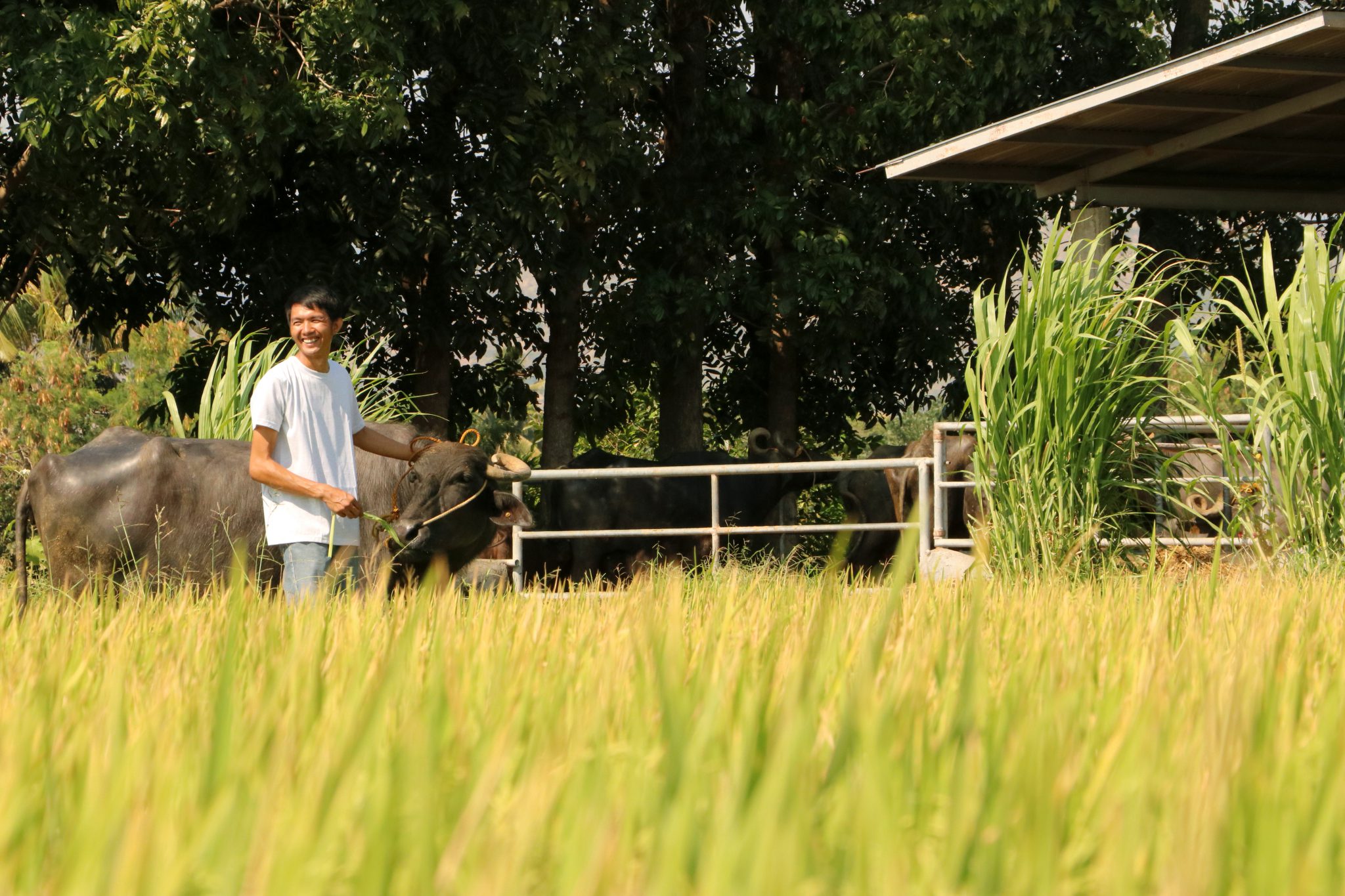In the heels of rice tariffication PCC exec’s advice to rice farmers: Integrate carabao dairying

SCIENCE CITY OF MUÑOZ – Farmers who are worrying about possible lowering of their income due to the effects of the Republic Act 11203, or the rice trade liberalization law may engage in other income-generating projects right in their own backyard. One such project is carabao dairying, suggested Dr. Arnel del Barrio, executive director of the Philippine Carabao Center (PCC), here. “In due time, the tended animals can give daily income because of their milk yield,” Dr. del Barrio said. “As the animals grow in number, the income may be comparable or even better than in rice farming,” he added. He also said that the farmers may set aside certain areas on their farm to grow corn and sorghum plants for silage-making for carabao feed which is now in great demand. “We have examples of farmers and entrepreneurs who made good in carabao dairying and rice farming at the same time and in silage-making,” the PCC executive director, who was interviewed at the sideline of the recent consultation here with stakeholders about the formulation of the implementing rules and regulations (IRR) of the new law, said. The consultation, attended by select stakeholders from the Cordillera Administrative Region (CAR) and from Regions 1, 2 and 3, was organized by the Department of Agriculture, National Economic Development Authority (NEDA) and other agencies. Citing as an example, Dr. del Barrio said Melchor Correa, 47, of San Jose City who, from subsistence farming, made good in carabao dairying. Then engaged in rice production during the rainy season and vegetable growing during the dry season, Melchor revealed that his income then could hardly suffice for the needs of his growing family. He said he incurred loans even from loan sharks. Then he heard about the Carabao Development Program of PCC which entrusts to cooperative purebred dairy buffaloes to serve as modular undertaking for dairying. One of the services of PCC to promote carabao development is the assistance for the development of carabao-based enterprises. “From one, he built a herd of 30 dairy buffaloes, with some of them lactating,” Dr. del Barrio said. “His buffaloes’ average daily milk yield recorded the other year was 57 liters which he sold for Php54 each liter or Php3,028,” he added. The cooperative, which he was then the chair, recorded a milk harvest of 145,099.50 liters valued at Php7,254,982.50. The milk harvest was from 91 carabaos. Or take this case of a young man, Moises Alfonso, 25, of San Jose City, who is a graduate of Bachelor of Science in Marine Transportation. He discarded his dream of seeing the world as a sailor and boldly took over the carabao dairying and rice farming enterprises of his family. “Moises saw how his late father, Carlito, then a subsistence farmer, engaged in carabao dairying and how he improved their family life through these enterprises,” Dr. del Barrio said. “When his father got sick, this young man did not hesitate to take over in managing their dairy farm and their rice farm,” he added. Citing the record of Moises, the PCC executive director said Moises is now tending a herd of 51 and a few hectares of their rice farm. “From dairying, the income of their family’s enterprise is Php2,000 to Php4,000 a day depending on the number of the lactating animals,” Dr. Del Barrio said. Moises, he said, set aside a portion of their rice field for the growing of their animals’ feed. As for the marketing of the carabao’s milk, the market for it is growing bigger as many establishments are doing milk-based products. In addition, there is a new law Republic Act 11037 or the “Masustansyang Pagkain para sa Batang Pilipino Act,” that institutionalizes a national feeding program for undernourished children in public day care, kindergarten and elementary schools. The milk for the feeding program will be bought from the farmers’ cooperatives, hence a big demand for locally produced milk. The PCC executive director said that farmers can set aside a portion of their rice field for growing of forages such as improved grasses, corn and sorghum plants for silage-making or carabao feed. “It’s a very lucrative business enterprise now,” he said. Isagani Cajucom of Lupao, is a chemical technician who was previously working in a company in Clark Freeport proved that there is high demand for silage and the income is very good. He was the “champion farmer” or farmer leader who participated in the project “Commercialization of Grass/Forage Corn Silage for Dairy Buffaloes through Technomart” launched by the Philippine Carabao Center (PCC) and funded by the Philippine Council for Agriculture, Aquatic and Natural Resources Research and Development (PCAARRD), where he saw a big opportunity in the production of quality silage. “Isagani tried first his silage-making venture by growing corn and napier in his farm. He sold his harvest to PCC and earned Php13,000 for his napier grass silage and Php20,000 for his corn silage,” Dr. del Barrio said. In his second cycle of planting and ensiling of corn, he harvested 34,000 kg which was sold at Php1.84 per kilogram. That was a cool profit of approximately Php62,000 for his one-hectare farm. He observed that the appropriate age of forage corn for harvest is between 75 and 80 days or when the corn kernel has about two-thirds milk-line (a distinct horizontal line that appears near the end of the corn kernel). The chopped corn plants including the ears are stored in a polyethylene sack with a capacity of 20-30 kg, for about three weeks before marketing or feeding to animals. Today, Isagani is selling on peak season 380 tons of silage and sells it at Php4.00 per kilogram. The main advantages of corn silage production, he said, are: it is not season-dependent as it can be done any time when there is forage abundance; it does not require sophisticated equipment, the shelf-life and quality of silage remain stable under longer storage time, and it can be prepared easily under small or commercial scale. In the consultation about rice tariffication, Agriculture Secretary Emmanuel Piñol said that under the law, anybody who has secured a phytosanitary clearance from the DA and has paid the tariff duties can import rice. He admitted that this law, officially titled “An act liberalizing the importation, exportation and trading of rice, lifting for the purpose the quantitative import restriction on rice”, can cause a lowering of the buying price of palay in the country. He added that the rice from some exporting countries can sell their produce at a very low price because of their low production cost. “But our government is ready to provide assistance to our farmers,” Piñol said. Dr. del Barrio agreed one hundred percent for not abandoning or lessening the intensity of rice production in the country for, as the Secretary Piñol said, this is a move tantamount to a suicide. “What is needed is for the farmers to be more competitive in so far as rice production in the country is concerned,” Dr. del Barrio said. “In dairy carabao raising, the farmers need not abandon rice production. They will find it as a complementary enterprise,” he added. He said the waste of the carabaos can be turned into vermicompost or organic fertilizer that can be used to enhance the fertility of the rice land. On the other hand, he added, the rice straw after harvest can be collected and turned into good carabao feed. “Just add urea and molasses to the rice straw, and a nutritious feed for the carabao can be produced,” Dr. del Barrio said. He said the men and women of PCC, including its top scientists, are ready to assist the farmers who would want to engage in carabao dairying as a source of additional income for their rice farming enterprise. “We are ready to give training in all aspects of carabao dairying. Our technicians, and those from other agencies are ready to give technical assistance right where carabao dairying venture is located,” Dr. del Barrio said.











